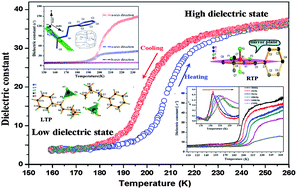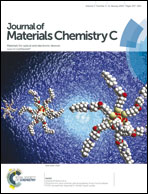N-Isopropylbenzylammonium tetrafluoroborate: an organic dielectric relaxor with a tunable transition between high and low dielectric states†
Abstract
An organic dielectric relaxor, N-isopropylbenzylammonium tetrafluoroborate (1), with tunable dielectric properties between high and low dielectric states, has been successfully constructed through the prominent strategies of reversible structure transitions associated with ordering and reorientation of molecular motions. 1 undergoes an exceptional order–disorder solid state phase transition at 201 K, which was confirmed by the variable temperature single crystal X-ray diffraction analysis, thermal analysis and dielectric measurements. Owing to the ordering of the pendulum-like motion of methyl groups in the N-isopropylbenzylammonium (N-IPBA) cations and the reorientation of the molecular dipoles, 1 demonstrates a phase transition from a space group of C2/m at room temperature to C2/c at low temperature. Emphatically, the striking anisotropy of the dielectric response was investigated, revealing the crucial role of the ordering and orientation motions of N-IPBA cations. Moreover, the significant dielectric relaxation behaviour, attributed to the orientational polarization of the molecules’ dipoles, was observed and discussed. Such distinctive dielectric performances suggest that 1 might be a potential switchable relaxor-type dielectric material.


 Please wait while we load your content...
Please wait while we load your content...